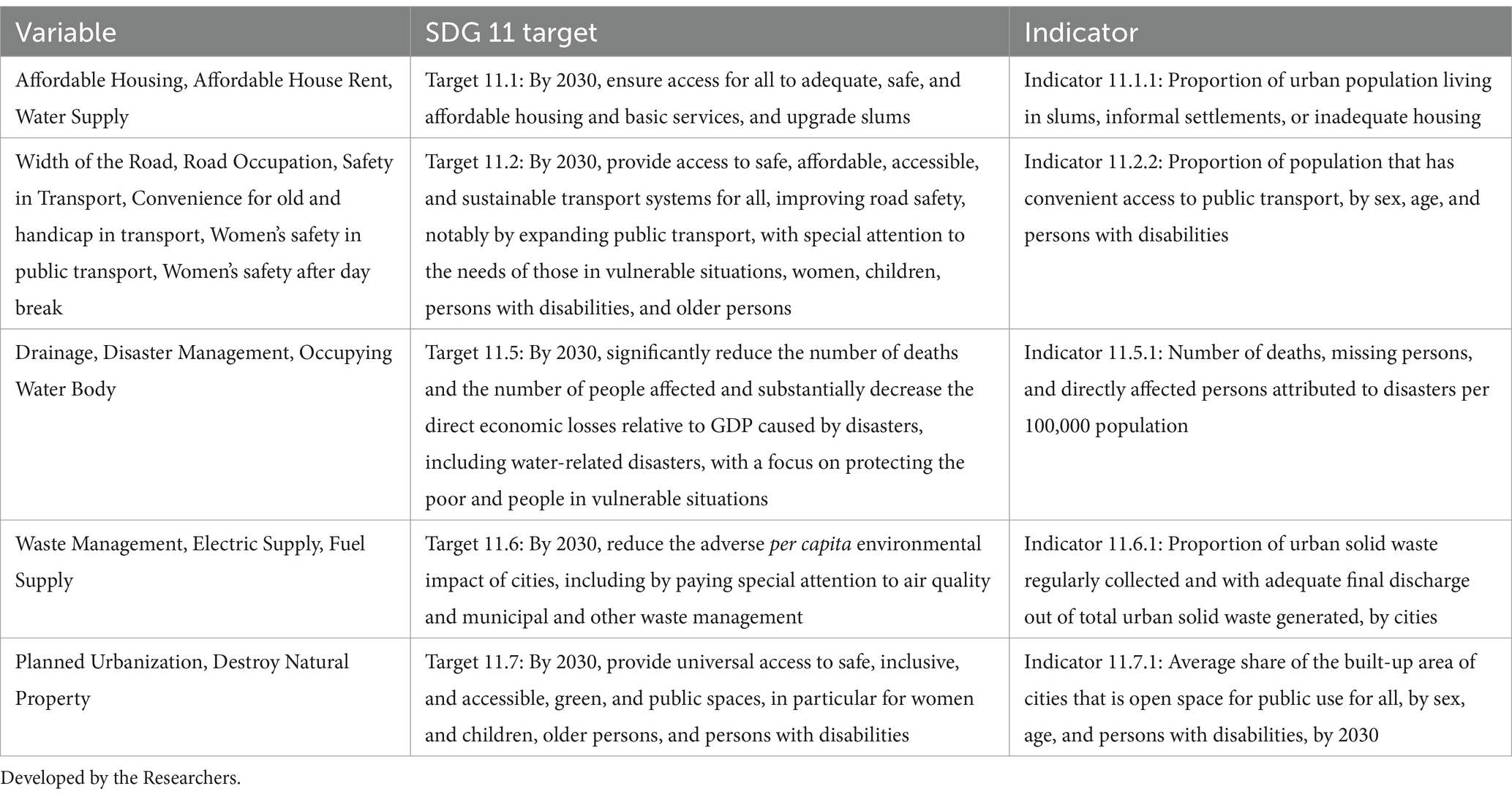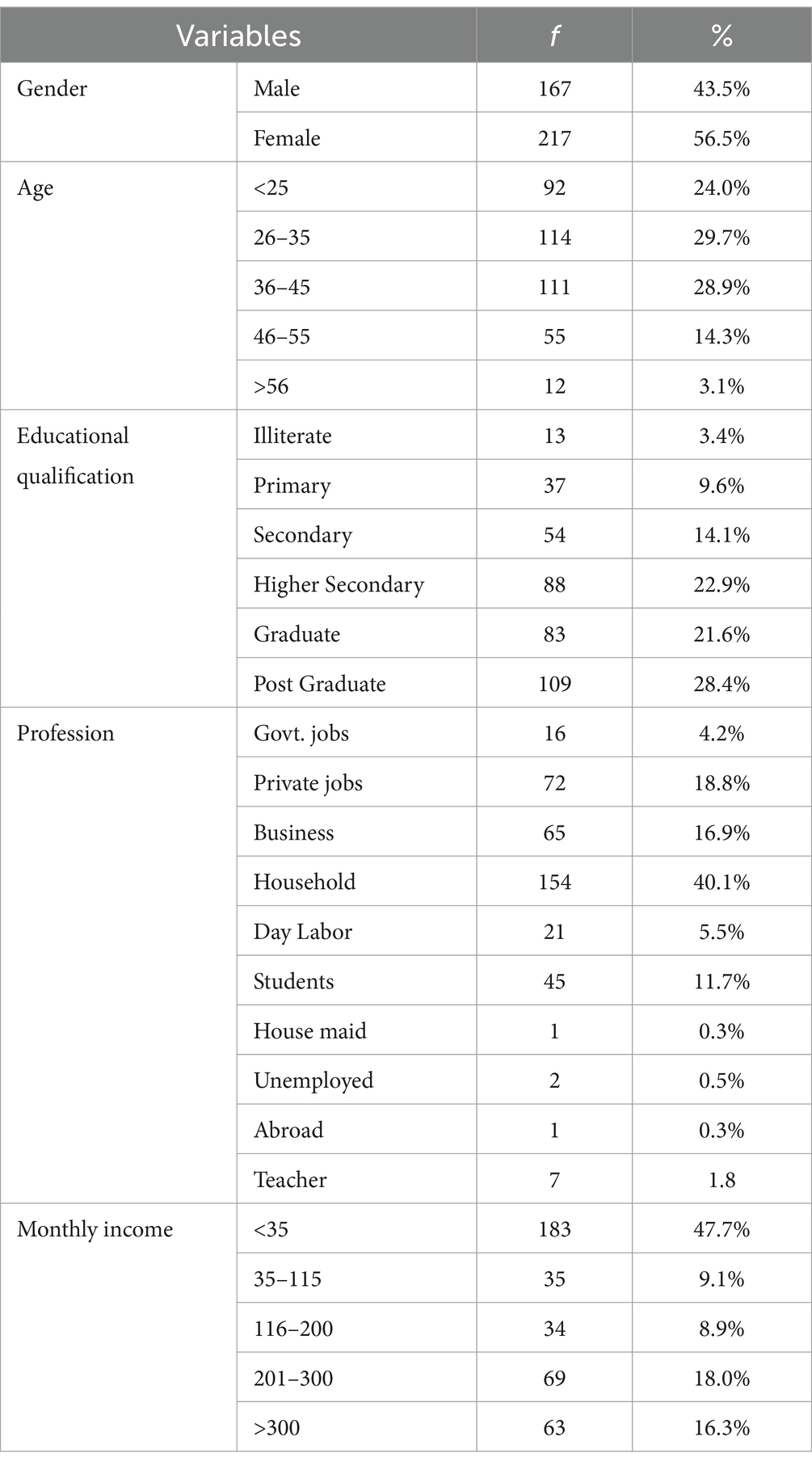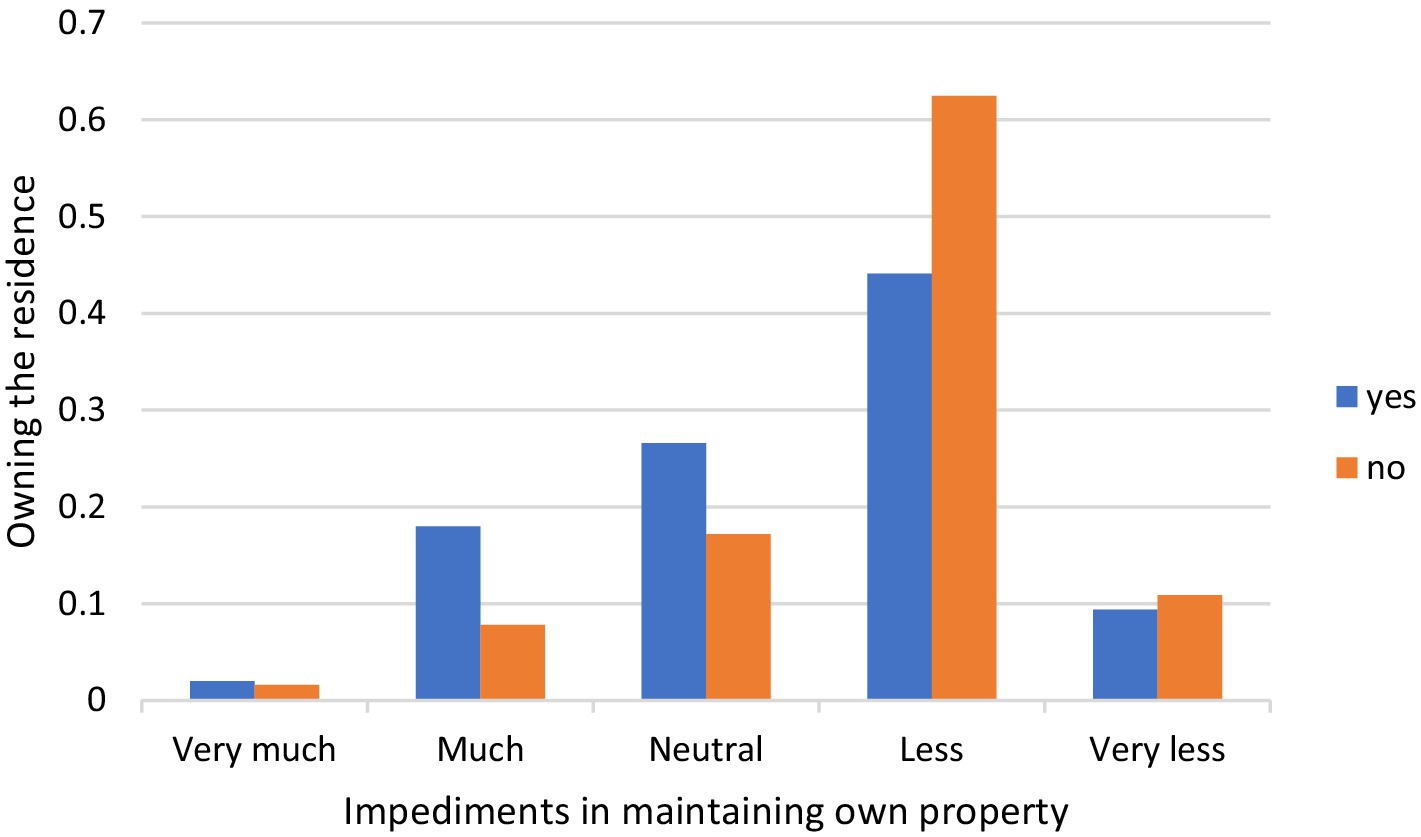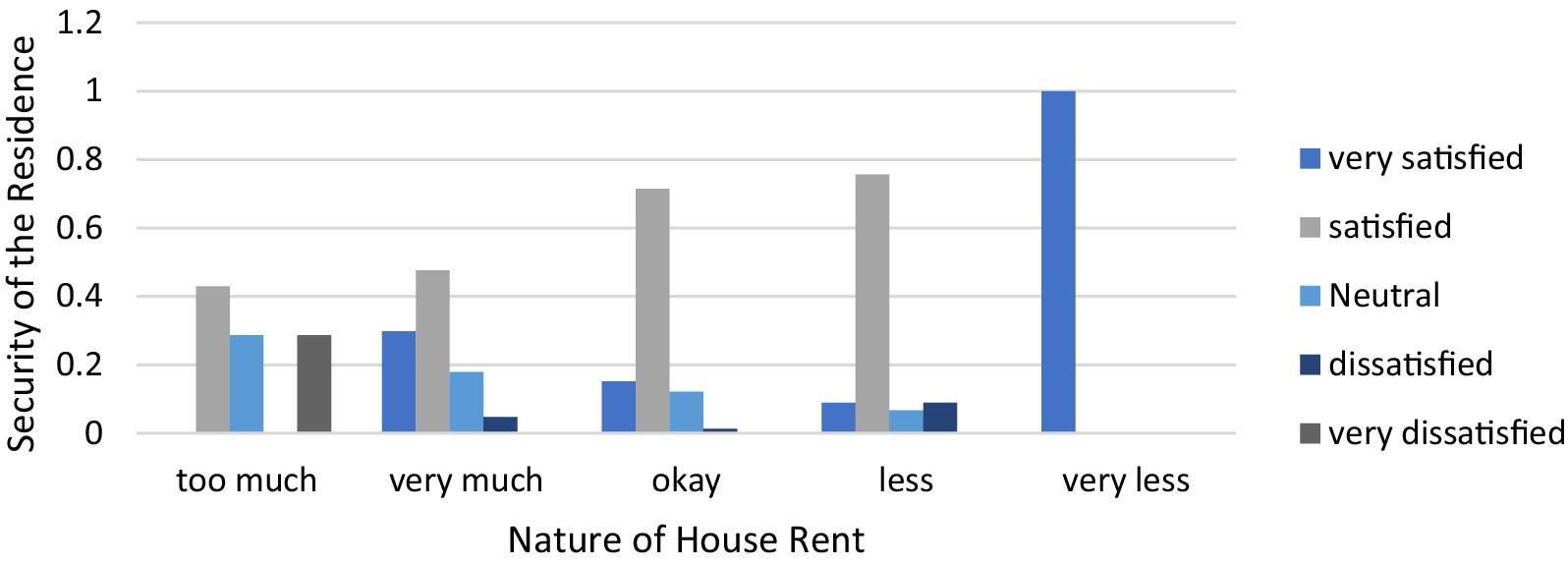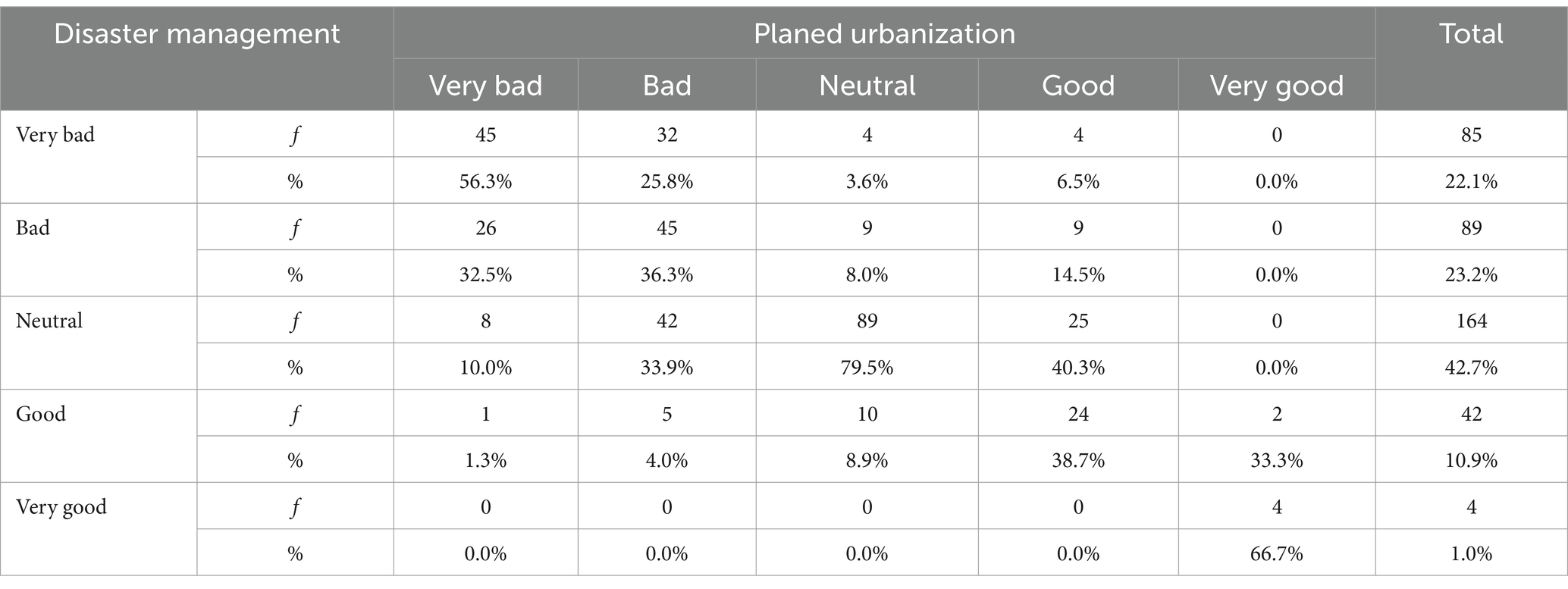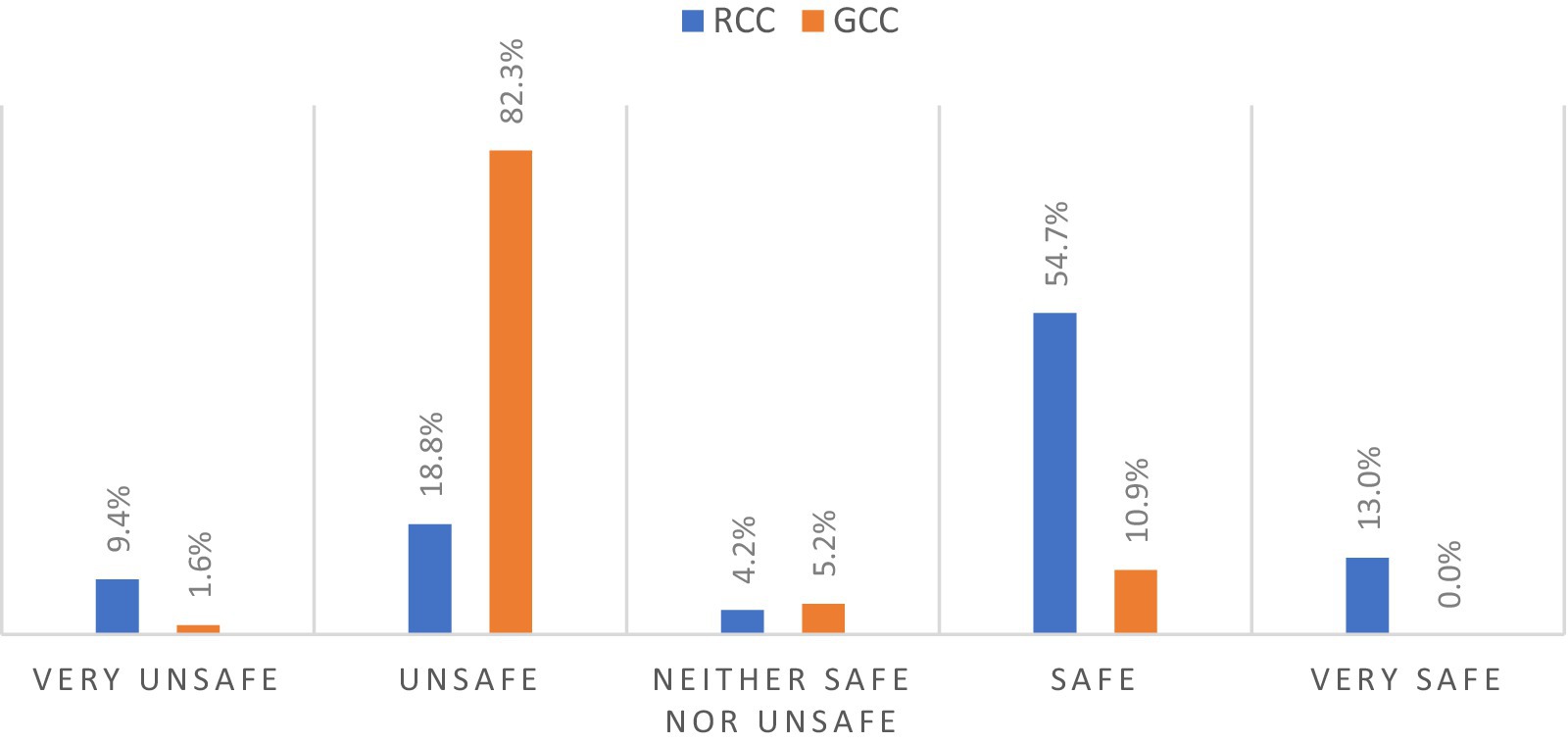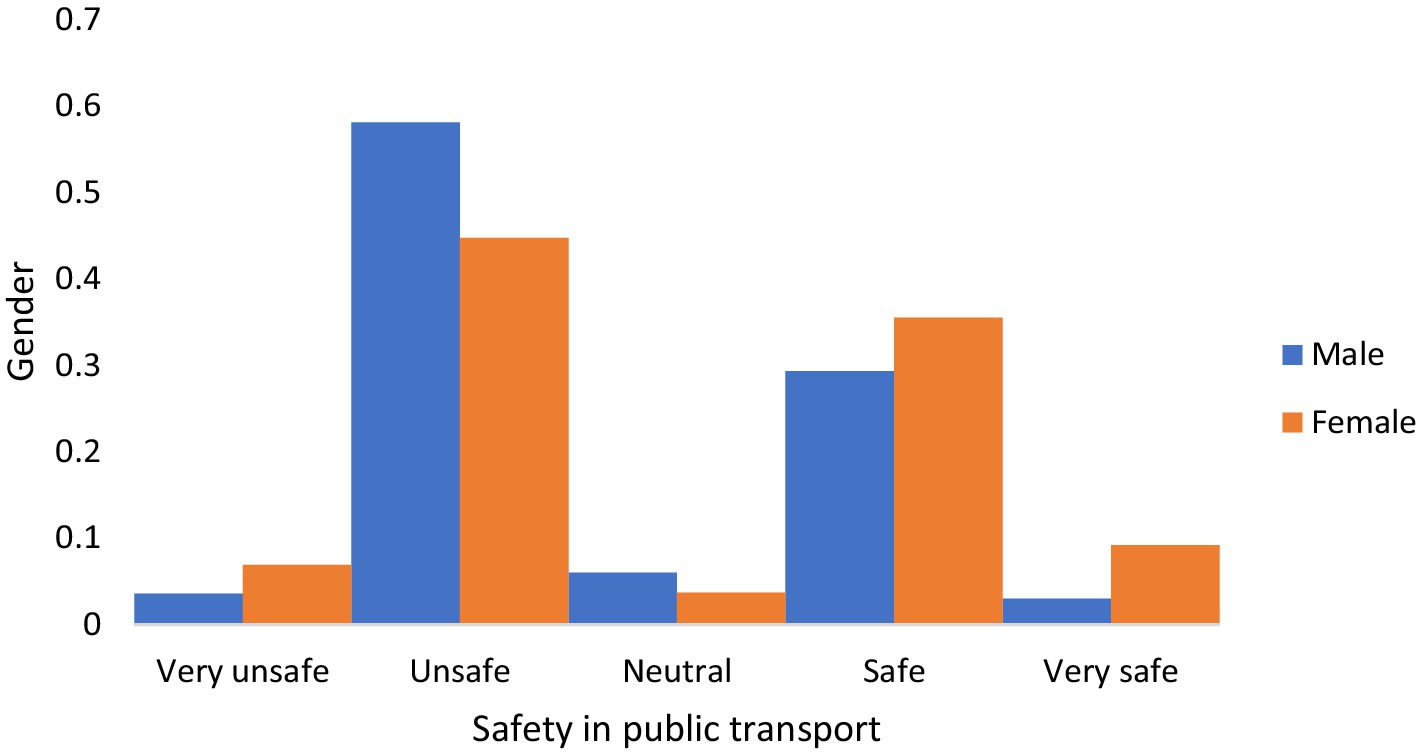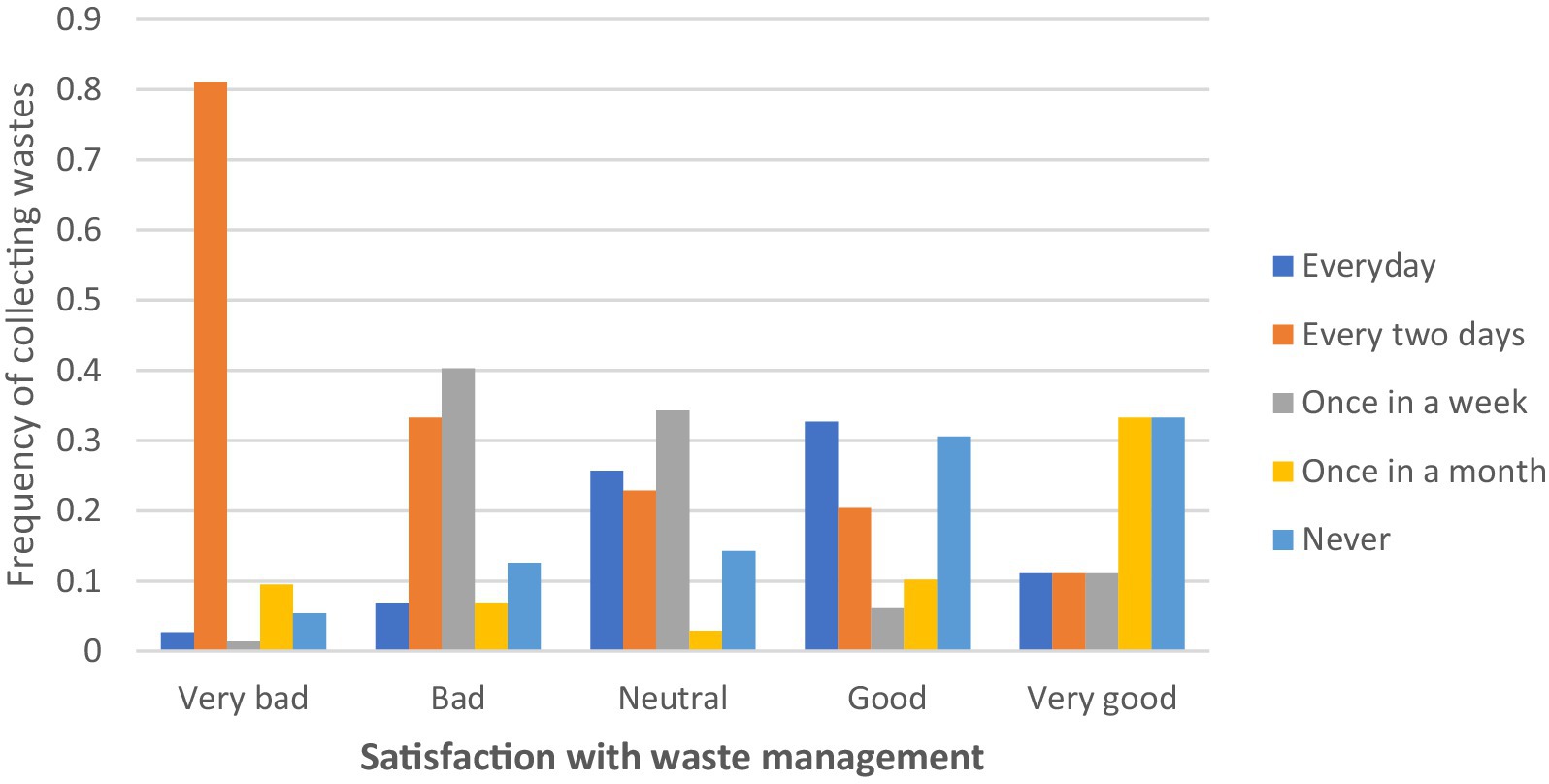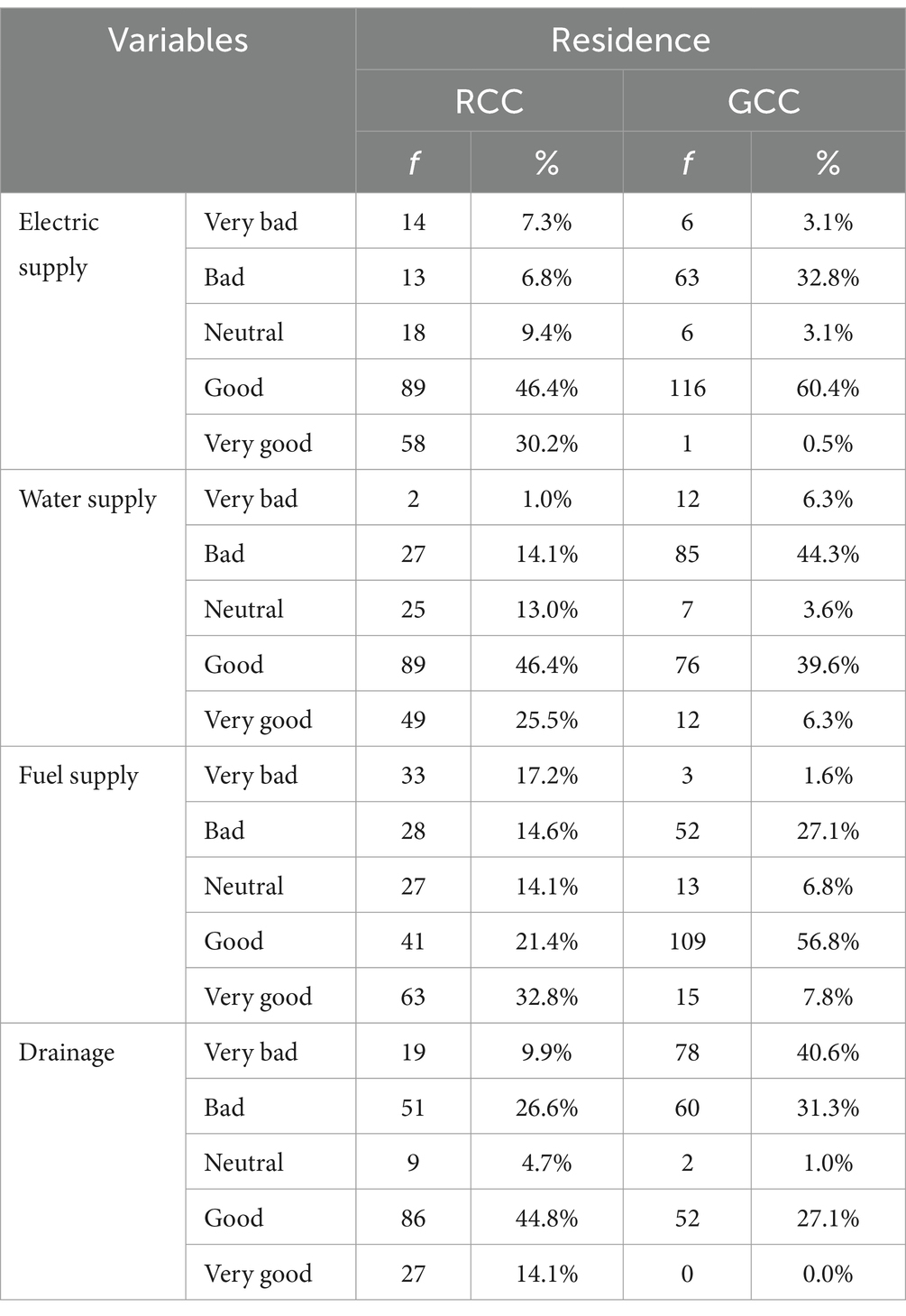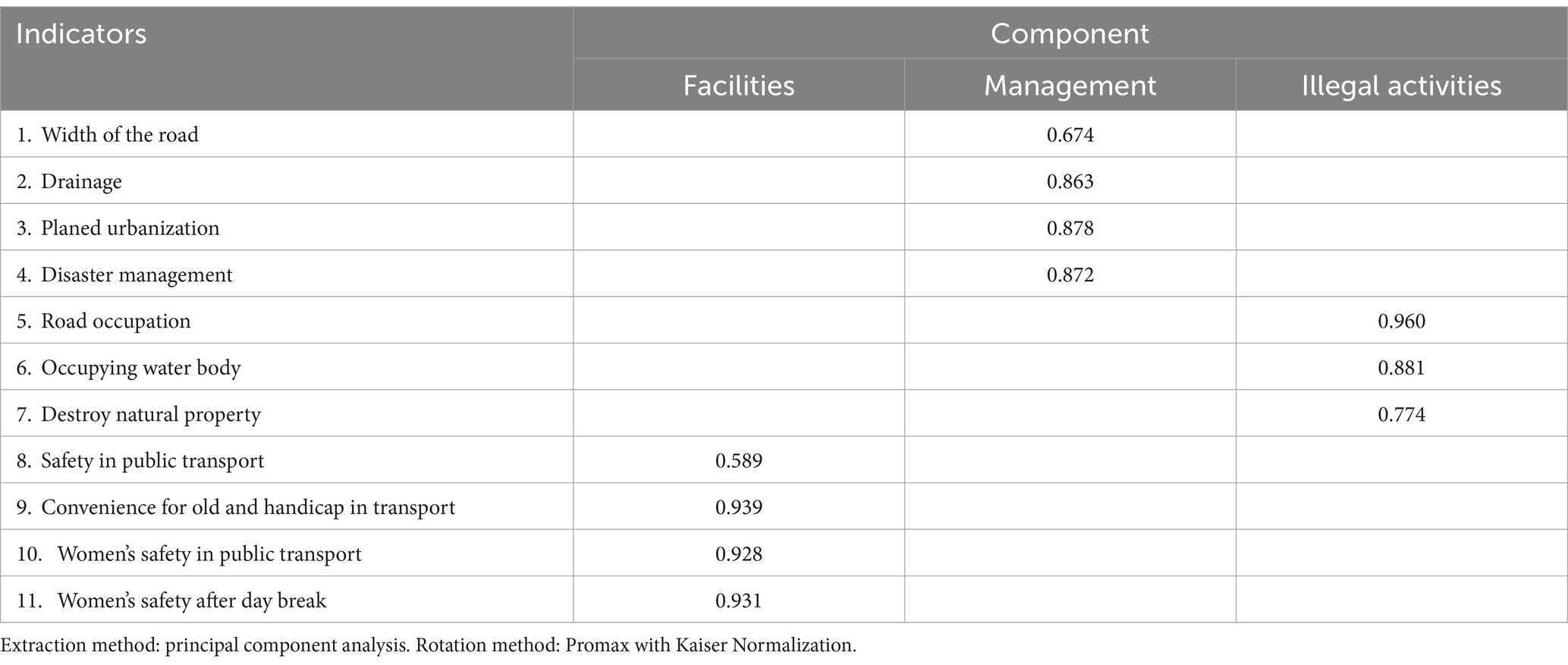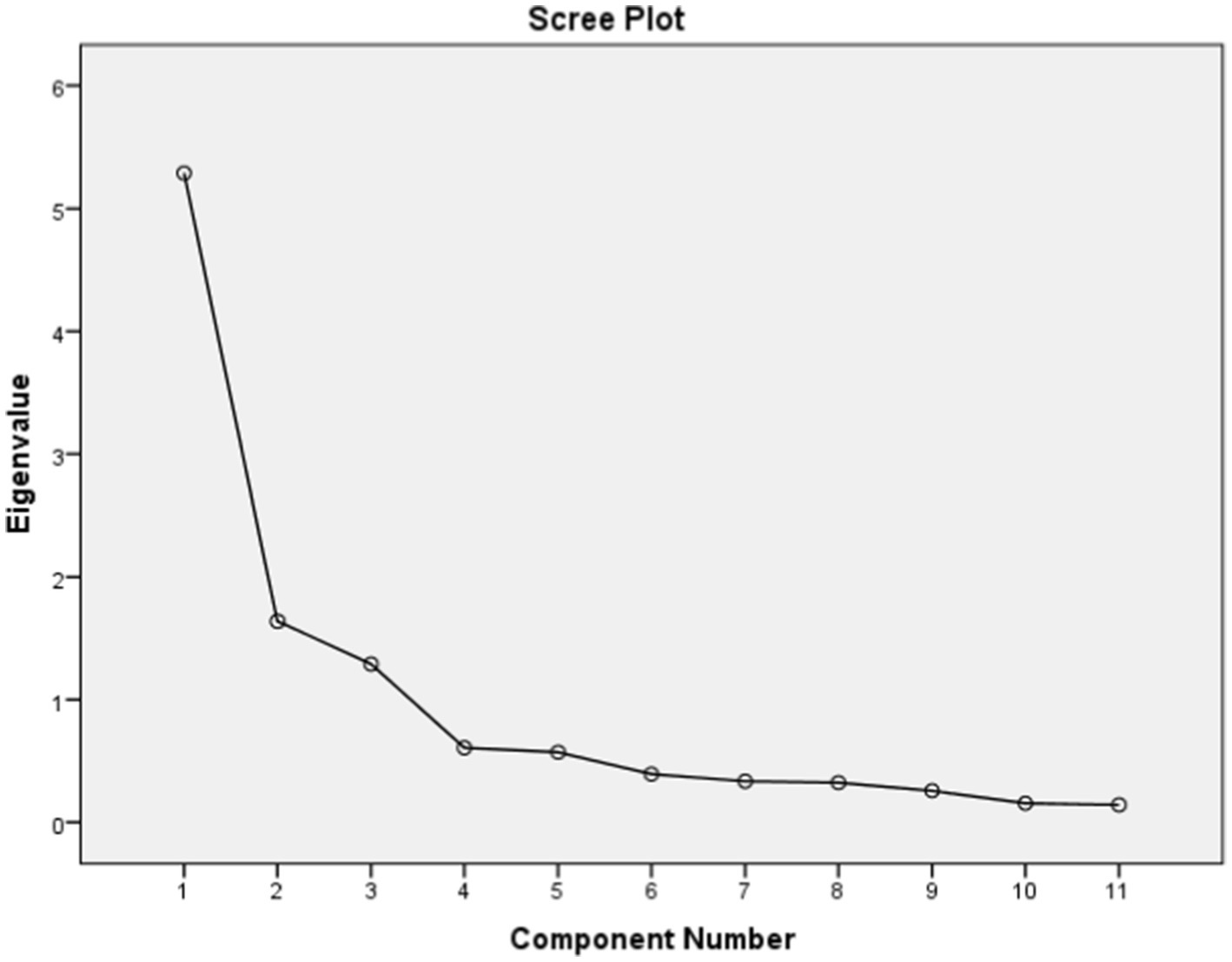- 1Department of Political Science, Varendra University, Rajshahi, Bangladesh
- 2Department of Political Science, University of Rajshahi, Rajshahi, Bangladesh
Bangladesh is going through an unprecedented period of urban growth, and its cities are having to deal with rising service, housing, and infrastructural needs. It is critical to comprehend how urban government promotes sustainable development as the nation struggles with the intricacies of urbanization. This study aims to investigate how urban governance impacts sustainable urbanization at the city corporation level in Bangladesh, focusing on Goal 11 of the Sustainable Development Agenda, which is “sustainable cities and communities.” The study selected Rajshahi and Gazipur City Corporations as case studies and employed Principal Component Analysis (PCA) and descriptive statistics methods to gather data from primary and secondary sources. The findings of the study reveal gaps in urban governance, highlighting inconsistencies between the expectations of stakeholders and the reality on the ground. Stakeholders express high expectations for housing access, infrastructure development, disaster management, transportation, and environmental sustainability, but the current state falls short in several areas. Further, the study proposes several recommendations to enhance urban governance, including fostering participatory approaches, ensuring sufficient budget allocation for infrastructure development, addressing housing challenges, enhancing women’s safety in transportation, and strengthening disaster management systems.
1 Introduction
Cities are hubs for economic development, modernization, and communication; they are also melting places for ideas, commerce, culture, research, and development in all of its social, human, and commercial manifestations (Girard, 2003; Henderson, 2010; Colenbrander, 2016; United Nations, 2020). They also face a host of complex challenges that hinder their sustainable development (Menes, 2003; Berry, 2018; Jones, 2019; Karmaker et al., 2023). Still, urbanization is a worldwide phenomenon that is changing the face of human settlement and development, especially in Bangladesh, where there are opportunities and problems associated with the country’s rapid urban growth (Uddin, 2018; Karmaker et al., 2023). The United Nations estimates that by 2050, 68% of people on Earth will live in urban areas, making up more than half of the world’s population (United Nations, 2020; Gu et al., 2021).
Primarily due to reasons like natural population growth, migration from rural to urban areas, and concentrated economic activity in urban areas, Bangladesh is experiencing unprecedented rates of urbanization (Bhattarai et al., 2021). Inadequate infrastructure, environmental degradation, a lack of affordable housing, and social inequality are only a few of the sustainability issues raised by this fast urbanization (Hasnat et al., 2018; Uddin, 2018). In light of these challenges, the concept of sustainable urbanization and human settlement is gaining traction, emphasizing the need for housing and urbanization that is economically, socially, and environmentally acceptable (Jones, 2017).
The World Bank (2022) reports that Bangladesh has had a 40% annual increase in its urban population, resulting in the extension of urban areas both horizontally and vertically. Due to the altered surroundings brought about by this growth, there is a greater need for resources, infrastructure, and services, among other demands. The quality of life for those who live in cities has been adversely affected by the unrestrained expansion of cities, leading to the depletion of natural resources, threats to biodiversity, the fundamental ecology, and environmental degradation (Hasnat et al., 2018; Bhattarai et al., 2021; Karmaker et al., 2023). Urban governance must be effective in order to handle these issues and encourage sustainable urbanization.
From land use planning to resource management, infrastructure provision, service delivery, and other facets of urban life, urban governance is a critical factor in determining how cities evolve (Habitat, 2013; Da Cruz et al., 2019). Adhering to the principles of sustainable development, effective urban governance guarantees that cities are administered in a sustainable, equitable, and inclusive manner (Sorensen, 2018; Pieterse, 2019). The role of urban government becomes even more significant in Bangladesh, where urbanization is happening quickly. Urban governance is led by city corporations, which are local government entities accountable for managing urban areas. They make crucial choices that have an immediate effect on the quality of life for urban people (Ahsan et al., 2021; Haque et al., 2022). Accordingly, it becomes essential to assess how well city corporations are doing in fostering sustainable urbanization.
Bangladesh is dedicated to accomplishing the eleventh Sustainable Development Goal (SDG 11), which is to “make human settlements and cities inclusive, safe, resilient, and sustainable” (Uddin, 2018; Haque A. K. M., 2019; Vaidya and Chatterji, 2020). The Bangladeshi government has incorporated SDG 11, which is focused on sustainability in the economy, society, and environment, into its Seventh Five-Year Plan (7FYP; Kamal, 2019). This is in line with the article of Vaidya and Chatterji (2020). The 7FYP has set specific objectives for the City Corporation, including ensuring affordable, secure, and ample housing; providing access to affordable, safe, and sustainable transportation systems; enhancing participatory planning for comprehensive and sustainable urbanization; reducing the negative environmental effects of urban areas; minimizing damages from natural disasters; and creating safe, inclusive, accessible, and green public spaces (Kamal, 2019; Mapping of Ministries of SDG-11, 2019). Nevertheless, the Bangladeshi governance institutions tasked with carrying out these responsibilities face formidable challenges, including insufficient funding, bureaucratic bottlenecks, indifferent stakeholders, unavailability of data, subpar management, inadequate supervision of sustainable development projects, and a lack of support for building technical capacity (Alam, 2004; Haque A. M. et al., 2023; Salehin, 2017).
In Bangladesh, city corporations, specifically those in RCC and GCC, are the focus of this study, which attempts to explore the role of urban government in fostering sustainable urbanization and human settlement. These two cities were specifically chosen because of their importance as Bangladesh’s two largest cities and the range of socioeconomic traits that they each possess. Within the framework of Goal 11 of the Sustainable Development Agenda, which is titled “sustainable cities and communities,” the purpose of this study is to evaluate how well RCC and GCC’s urban governance mechanisms adhere to sustainable urban development principles (Uddin, 2018; Vaidya and Chatterji, 2020). Furthermore, the study has examined how crucial it is for stakeholders to be effectively engaged in order to achieve equitable and sustainable urban development outcomes, highlighting the necessity of participatory methods in urban governance procedures.
2 Literature review
One notable aspect of the modern world is urbanization, a global phenomenon defined by the growing concentration of people in metropolitan areas (Gu, 2019; Gu et al., 2021). This tendency is especially evident in Bangladesh, where a sizable percentage of the population moves from rural to urban regions in quest of better living circumstances and employment possibilities (Uddin, 2018; Evertsen and van der Geest, 2020; Karmaker et al., 2023). Due to this, cities like RCC and GCC are expanding quickly, posing previously unheard-of opportunities and problems (Hasan and Khatun, 2020; Murad et al., 2022; Haque N. M. Z. et al., 2023). Although urbanization presents opportunities for social advancement, economic expansion, and innovation, it also raises a number of sustainability issues that need to be resolved in order to maintain prosperity and well-being over the long run (Bhattarai et al., 2021).
Bangladesh’s urban infrastructure is under extreme strain due to the country’s fast urbanization, which has resulted in overpopulation, inadequate housing, and overstretched public services (Khan et al., 2014; Rahman and Rahman, 2015). Rana (2011) sheds light on the various issues that urban Bangladesh faces, such as inadequate infrastructure, poor governance, poor urban planning, a lack of basic amenities, environmental degradation, chronic traffic jams that result in accidents, and socioeconomic insecurities that fuel violence. Haque M. (2019) emphasized the critical issues of poor governance for water management, inadequate amenities for slum dwellers, and the continuous water crises in urban Bangladesh, underscoring the significance of water-related issues in preserving urban life. Haq et al. (2014) also noted a number of important barriers to Dhaka’s sustainability, such as the complexity of leaders covert operations, urbanization, migration concerns, and the looming water crisis.
Adding to this narrative, Akash et al. (2018) emphasized the detrimental impacts of rapid urbanization, pollution, deteriorating environmental conditions, limited public awareness of sustainable practices, and a dearth of public participation in promoting sustainable urban development. In-depth research by Roy et al. (2021) reveals that urban Bangladesh is confronted with a multitude of challenges, such as growing housing demand, exorbitant living costs, population growth pressures, weak development regulations, cramped housing, limited accessibility, and poor drainage and sanitary infrastructure. By highlighting issues such as the dearth of accessible housing and infrastructure, the disappearance of public parks and green spaces, the deterioration of surface water quality due to over-exploitation of groundwater, the high population density and quick urbanization, and the environmental effects of industrialization, Siddiqy (2017) provided a comprehensive view. Furthermore, Abdullah et al. (2010) underlined the issues that metropolitan Bangladesh is dealing with, such as poor environmental services, gridlock that results in accidents, and societal vulnerabilities that encourage violence. In addition, Zaman et al. (2010) provided clarification on the complex issues that urban Bangladesh faces, pointing out issues brought on by unplanned urbanization, shoddy planning for road infrastructure and public transportation, inadequate environmental considerations, and a lack of concern for the welfare of the underprivileged and slum dwellers.
A framework for tackling these issues and advancing sustainable urbanization is provided by the Sustainable Development Goals (SDGs), which were endorsed by the UN in 2015 (Uddin, 2018; Haque A. K. M., 2019; Vaidya and Chatterji, 2020). Targeting “sustainable cities and communities,” Goal 11 of the SDGs emphasizes the need to guarantee access to secure and affordable housing, sustainable transportation systems, and inclusive urban planning and management (Vaidya and Chatterji, 2020). Many factors are taken into account while discussing sustainable urbanization, such as social justice, economic feasibility, environmental sustainability, and the efficacy of governance (World Bank, 2019).
The components and principles of sustainable urban development have been examined and monitored in numerous studies (Deakin and Reid, 2014). The idea of economic sustainability includes smart growth initiatives that support the local economy and businesses in addition to maintaining agricultural zones, removing brownfields, establishing echo-industrial parks, allowing for infill development, and delineating boundaries for urban growth (Saha and Paterson, 2008). Environmental sustainability indicators include things like alternative energy, energy-saving projects, green buildings, open space preservation, and the protection of the natural environment (Scipioni et al., 2009).
A few of the many diverse initiatives that go into fostering social inclusion and equity include the development of affordable housing, the prevention and treatment of homelessness, the support of women- and minority-owned businesses, youth development and opportunity, education, health, and security, as well as the improvement of accessibility to public open spaces and services (Huang and Rust, 2011). Although it is not a pillar, effective governance—which encompasses accountability, openness, public involvement, and the empowerment of underprivileged and minority groups—is crucial for sustainable urban development (Yigitcanlar and Teriman, 2015).
The City Prosperity Initiative (CPI), developed by UN-Habitat, provides a collection of indicators to assess sustainable urban development and guide planning and policy decisions (United Nations Human Settlements Programme, 2017). These indicators include six categories: governance, social development and inclusion, economic growth, and environmental protection. Each category is associated with a pillar of sustainable urban development. Sustainable policies can be shown in the advancement of public infrastructure, quality of life, social inclusion, environmental sustainability, urban governance, and legislation (United Nations Human Settlements Programme, 2017).
The process of balancing urban life’s social, environmental, and economic components is known as sustainable urbanization (Hassan and Lee, 2015). This strategy is required because of the problems with urban poverty, population increase, global warming, and social-spatial changes—especially in developing countries (Jaafar, 2015). It is crucial to take into account the three pillars of sustainable urbanization—economic development, social development and inclusion, and environmental protection—in order to address these intricate issues (Hassan and Lee, 2015). Sustainable development has to place a high priority on striking a balance between these pillars in order to comprehend and regulate the relationships between the social, economic, and environmental components of urbanism (Sachs, 2015). Achieving this difficult balance requires effective governance at all levels, involving the public, commercial, and social sectors (Rasoolimanesh et al., 2012). But achieving sustainable urban development calls for innovative approaches to governance that balance meeting the demands of the populace and promoting economic growth with consideration for social inclusion, environmental concerns, and stakeholder participation (Yigitcanlar and Teriman, 2015).
Through its impact on land use planning, infrastructure supply, service delivery, resource management, and other aspects of urban development, urban governance is crucial in determining the course of sustainable urbanization (Habitat, 2013; Da Cruz et al., 2019). According to Sorensen (2018) and Pieterse (2019), efficient urban governance makes sure that cities are run in a way that is equitable, inclusive, and sustainable. This is consistent with the ideals of sustainable development. Urban government has an even more crucial role in Bangladesh because urbanization is happening very quickly. Urban governance is led by city corporations, which are local government entities accountable for managing urban areas. They make crucial choices that have an immediate effect on the quality of life for urban people (Ahsan et al., 2021; Haque et al., 2022). Thus, in order to determine how well urban governance systems work to address the sustainability issues that Bangladeshi cities are confronting, it is imperative that the performance of city corporations in promoting sustainable urbanization be evaluated.
Comprehensive policy reforms that build institutional capacity, improve accountability and transparency, and encourage multi-stakeholder engagement are required to solve these governance issues and advance sustainable urbanization (World Bank, 2019). A mix of bottom-up grassroots efforts and top-down policy interventions that enable local communities and civil society organizations to actively participate in decision-making processes is needed to improve urban governance (Habitat, 2013). To ensure that cities can adapt to shifting socioeconomic and environmental dynamics, it is also crucial to invest in the development of human capital and strengthen the ability of municipal institutions to plan, manage, and control urban expansion.
3 Methodology of the study
In order to better understand how urban governance contributes to sustainable urbanization and human settlement at the city corporation level in Bangladesh, this study uses an empirical research technique. Principal Component Analysis (PCA) is the empirical technique used, with data analysis assisted by descriptive statistics.
Two cities, such as GCC and RCC, have been chosen for data collection. These cities were purposefully chosen by taking into account the collection of related geographic regions, distinctive regional traits, and dearth of published works. The chosen cities are ideally distributed around the nation, guaranteeing geographic representation and capturing distinctive regional traits. RCC is a city in northwest Bangladesh that struggles with extreme poverty, poor housing and infrastructure, and a lack of urban amenities (Rahman and Rahman, 2015; Murad et al., 2022; Hossain et al., 2023a). GCC is a city in central Bangladesh that is rapidly becoming more urbanized and industrialized. This has resulted in issues with waste management, pollution of the environment, land grabbing, various illegal activities, etc. (Khan et al., 2014; Haque et al., 2022; Haque N. M. Z. et al., 2023; Hossain et al., 2023b).
A total of 384 people were included in the study, distributed across the two chosen city corporations of RCC (192 participants) and GCC (192 participants). Based on inclusion and statistical validity standards, the sample size was chosen at random to ensure representation of a range of sociodemographic factors, including gender, age, occupation, education, and household income. A multi-phase sampling strategy was used. Wards, or sub-local administrative regions, were assigned to each city corporation as clusters. A set of wards from each of the chosen city corporations was chosen using the cluster sampling method. Then, within each ward, the respondents were selected using a straightforward random sampling procedure, guaranteeing a representative sample that captures the variety of features of the local community. The questionnaire recorded the respondent’s demographics, such as age, gender, profession, and degree of education. In city corporation areas, respondents were asked to rate the current situation of each urban issue. On a 5-point Likert scale, they indicated how they felt about the current situation of all urban issues pertaining to sustainable urbanization.
Along with the quantitative analysis in this study, key informant interviews (KIIs) with mayors, councilors, government officials, policymakers, members of civil society, and other relevant stakeholders were used to gather qualitative information. This was done to make the analytical results more broad and deep. Two Focus Group Discussions (FGDs) with 10 carefully chosen respondents each are held in each city corporation to augment the quantitative data. These conversations guarantee a wide representation of perspectives from local elites, NGOs, CSOs, development partners, and professional associations. They also offer nuanced insights into SDG 11 implementation and identify important barriers.
For the quantitative data, a variety of statistical methods were used. Software such as Statistical Software Packages for Social Science (SPSS) was used for all quantitative analysis. The chi-square test, exploratory factor analysis, and descriptive analysis were among the statistical methods used in quantitative analyses. The purpose of the descriptive analysis was to ascertain the background characteristics of the respondents. Since the ultimate goal of this study is to evaluate the SDG 11 indicators (Table 1), exploratory factor analysis (EFA) was utilized to create a factor model that includes the SDG 11 indicators. The reason factor analysis is used is because of its capacity to reveal hidden patterns and structures in observed variables. With this multivariate statistical method (Watkins, 2018; Omura et al., 2022), it is possible to find a small group of hypotheses that explain the observed connections between measured variables. Anyway, an exploratory factor analysis was done using Principal Axis Factoring Extraction (PAF) and the Promax rotation technique, which is a way to deal with correlated variables and explain the most variance on average. This was done with the assumption that the urban issues under each determinant factor in the assumed construction are linked. The factor structure of the various sets of observed urban concerns with loading communality scores of 0.30 and higher was created using an Eigenvalue >1 approach. A 99% confidence level was reached by utilizing Bartlett’s Test of Sphericity and the Kaiser-Meyer-Olkin Measure of Sampling Adequacy to determine the test’s significance.
3.1 Selection of variables for measuring sustainable urbanization
The United Nations’ goals and a multifaceted understanding of the issues facing urban development underlie the selection of factors for evaluating sustainable urbanization performance (SDG 11). Every selected variable reflects an essential component of urban governance and existence that has a direct impact on the sustainability and general livability of cities. Based on previously published research and approved frameworks for sustainable urban planning, these factors have been determined.
First of all, according to Habitat (2020), access to housing is seen as a basic human right and a crucial sign of urban growth. The availability and cost of housing have a direct bearing on urban dwellers’ quality of life and wellbeing (Wood et al., 2008). Second, according to Vaidya and Chatterji (2020) and Khorrami et al. (2021), livability in cities is influenced by a number of elements, including house rent, road width, road occupancy, drainage, and garbage management. In addition, planned urbanization is necessary to guarantee the economical use of resources and land while regulating urban growth in a sustainable manner (Kamal, 2019; Vaidya and Chatterji, 2020). Improving cities’ ability to combat natural disasters and the effects of climate change requires effective disaster management (Baker, 2012). To further boost economic activity and address the demands of urban populations, access to basic amenities including fuel, water, and power is necessary (World Bank, 2019). Moreover, the conservation of natural resources like green spaces and water bodies is crucial to preserving ecological balance and biodiversity in urban settings (Semeraro et al., 2021). Establishing inclusive and equitable cities requires prioritizing accessibility for vulnerable populations, such as the elderly and those with disabilities, and ensuring transportation safety (Sze and Christensen, 2017).
Ultimately, advancing gender equality and enabling women to fully engage in urban life require tackling gender-specific issues, such as women’s safety in public transportation (Sze and Christensen, 2017; Women, 2020). Through a thorough evaluation of these factors, the research seeks to shed light on the situation of sustainable urbanization today and guide the development of urban planning and policy initiatives targeted at reaching SDG 11 targets.
4 Results and discussion
4.1 Socio-demographic characteristics of the respondents
The demographic analysis of the responders indicates a large sample size. Because the majority of respondents (56.5%) were female, the study has a notable representation of women (Table 2). The sample has a wide age distribution, with the largest proportion (29.7%) falling between the ages of 26 and 35. In terms of education, higher secondary education ranked second (22.9%), with post-graduation degrees holding a majority of the responses (28.4%). When it came to occupation, a substantial plurality (40.1%) worked at home, while smaller numbers (4.2% and 16.9%, respectively) were employed by the government or as independent businesses. An intriguing result that suggests socioeconomic disparities in the sample is that the majority of respondents (47.7%) reported making less than $50 USD per month (Table 2). This demographic diversity provides a comprehensive framework for understanding the attitudes and behaviors of individual citizens with regard to sustainable urbanization activities. The fact that a sizable percentage of respondents work from home raises the possibility of their being interested in eco-friendly procedures and wanting flexibility in their working environment. The income data’s economic discrepancy highlights the necessity for equitable and inclusive urban development policies that cater to the requirements of the entire community.
4.2 Adequate and affordable housing services
Access to shelter is essential to the development of sustainable cities. In addition to raising people’s quality of life, ensuring that everyone has access to decent and affordable housing supports metropolitan regions’ overall sustainability (Pugh, 2013). Sustainable cities place a high priority on providing equal access to housing while taking into account the needs of all citizens, particularly the underprivileged, marginalized groups, and vulnerable populations. This entails carrying out programs and policies that deal with the availability, affordability, and quality of housing (Jianfa, 2015). According to this survey, the ownership of homes in the RCC and GCC regions differs significantly from one another. The number of people without shelter is higher in the RCC, even though most people live in both areas in their own homes. This emphasizes how urgent it is that the RCC’s governance move to boost the residency rate and guarantee that every resident has access to a secure place to live.
For understanding the relationship between impediments to maintaining one’s own property and ownership of the residence, a Chi-square test has been used. The chi-square test results are presented in Figure 1. The chi-square test was statistically significant, X2(4, N = 384) = 15.240, p < 0.05, with a Phi and Cramer’s V (φ) coefficient of 0.399, indicating a moderate relationship between the impediments to maintaining own property and ownership of the residence. The same findings are demonstrated by Cohen (2013) in his book as well. This finding suggests that there is a significant association between the challenges faced by individuals in maintaining their own property and their ability to own a residence. The Phi and Cramer’s V coefficients indicate that this relationship is moderate, which implies that there may be other factors at play that affect ownership of a residence. It is important to note that these results are based on a sample size of 384 individuals, so further research with larger sample sizes may be necessary to confirm these findings. Nonetheless, this study provides valuable insights into the obstacles faced by individuals in maintaining their own property and how they relate to their ability to own a residence. These findings can inform policies and programs aimed at improving access to affordable housing and supporting homeownership for all individuals, regardless of their socioeconomic status or other factors that may affect their ability to maintain their property.
4.3 Affordable house rent
A key factor in developing sustainable cities is rent affordability. Urban areas can be more socially, economically, and environmentally sustainable if residents have access to affordable housing (Mulliner et al., 2013; Charoenkit and Kumar, 2014). Implementing policies and tactics that support affordability, discourage gentrification, and foster inclusive communities is key to addressing the problem of housing rent in sustainable cities. Therefore, it is crucial for city planners and policymakers to prioritize the development of affordable housing options to ensure that urban areas are livable for all residents, regardless of their income level (Charoenkit and Kumar, 2014). By doing so, sustainable cities can be achieved, where economic growth and environmental protection go hand in hand with social equity and inclusion. Figure 2 summarizes the opinions of the key players regarding the characteristics of rental housing.
The majority of respondents in both RCC and GCC feel that their house rent is either okay or high. However, the percentage of respondents who feel that their rent is high is significantly higher in RCC compared to GCC. It is also worth noting that the GCC has been effective in managing house rent prices in GCC. This study demonstrates that a significant portion of RCC residents feel that their house rent is high, while the majority of GCC residents feel that their house rent is okay. The GCC’s efforts in managing house rent seem to have been effective in ensuring that residents are satisfied with their housing costs.
From Figure 2, we observe that most of the people in RCC and GCC are satisfied with their house rent (71.5%) and the quality of their housing. This study suggests that while there is a high level of satisfaction with housing and rent among residents of RCC and GCC, there are still challenges to be addressed in terms of providing adequate housing for slum dwellers. This highlights the need for continued efforts to improve access to affordable and quality housing for all residents in the area. It is clear that RCC and GCC are generally good places to live, but there are still areas where improvements can be made to enhance the quality of life for residents. By addressing these issues and continuing to invest in community development initiatives, we can ensure that these neighborhoods remain vibrant and thriving places for years to come.
4.4 Disaster management
Disasters are severe setbacks to the functioning of a community that exceeds its capacity to handle using its own possessions (Makwana, 2019). Natural, man-made, and technical risks, as well as a number of other variables that affect a community’s exposure and vulnerability, can all result in disasters. There are various types of disasters, like earthquakes, volcanic eruptions, landslides, tsunamis, floods, heat waves, cold waves, etc. (Rosselló et al., 2020). Factors such as climate change, displacement, conflict, rapid and unplanned urbanization, technological hazards, and public health emergencies are likely to be responsible for the regularity, difficulty, and severity of their impacts in the future (World Health Organization, 2013). But disasters should be prevented. By assisting communities in planning ahead, lowering their risks, and building more resilient infrastructure, we can stop hazards from turning into disasters. Respondents’ opinions about this are mentioned in Table 3.
The Chi-square test of independence was conducted to explore the relationship between disaster management and planned urbanization. Bae et al. (2016) also suggest that proper urban planning can reduce harmful disasters. The analysis included data from 384 participants. The results revealed a significant association between disaster management and planned urbanization, χ2(16, N = 384) =466.685, p = 0.00. As the p-value is less than the significance level (p < 0.05), we can state that there is a statistically significant association between disaster management and planned urbanization. Moreover, Cramer’s V (V = 0.551) indicated a moderate association between disaster management and planned urbanization. The study suggests that the two variables are not completely independent of each other. This finding has important implications for policymakers and urban planners, as it highlights the need to incorporate disaster management strategies into urban planning efforts. By doing so, cities can better prepare for and respond to natural disasters, reducing the risk of loss of life and property damage. Additionally, this study underscores the importance of interdisciplinary collaboration between disaster management experts and urban planners to create more resilient and sustainable communities.
4.5 Safety in public transport
According to Cardona (2013), safety is the state in which conditions and hazards that could endanger someone’s physical, mental, or spiritual health are managed to safeguard individual members’ health and welfare, as well as the health of the community. This is usually accomplished by using a mix of laws, guidelines, and practices intended to reduce or eliminate possible risks. Standards for workplace safety, for instance, are implemented to prevent mishaps and injuries at work, while laws governing food safety guarantee that the food we eat is safe from dangerous substances. Public health policies deal with matters like immunization programs and illness prevention, whereas environmental rules try to safeguard natural resources and avoid pollution (Corvalan et al., 2020). In the end, risk management is about being proactive in spotting possible dangers and dealing with them before they have a chance to cause damage. By doing this, we can make everyone’s neighborhoods safer and healthier. Below is a discussion of some particular concerns that help us determine whether or not the safety of the residents of the RCC and GCC is maintained.
Figure 3 states that the RCC performs better than the GCC in terms of ensuring public transportation safety. 54.7% of respondents overall feel safe in the RCC, and 13% of respondents feel very safe when using public transportation. On the other hand, 28.2% of respondents—18.8% of whom reported feeling unsafe and 9.4% reported feeling very unsafe—felt unsafe when moving. However, in the GCC, only 10.9% of residents are satisfied, and 82.3% of residents report feeling unsafe when moving from one location to another. For example, in the RCC, the implementation of safety measures such as CCTV cameras and emergency buttons on public transportation has contributed to a higher percentage of respondents feeling safe. In contrast, the lack of similar safety measures in the GCC may have led to the majority of residents feeling unsafe while using public transportation. This study found that the RCC performs better than the GCC in terms of ensuring public transportation safety. The implementation of safety measures such as CCTV cameras and emergency buttons on public transportation in the RCC has contributed to a higher percentage of respondents feeling safe. In contrast, the lack of similar safety measures in the GCC may have led to the majority of residents feeling unsafe while using public transportation (Figure 3).
The results of the Chi-square test indicate a statistically significant association between safety in public transport and gender, χ2(4, N = 384) = 13.012, p = 0.04. The p-value of 0.04 is less than the significance level of 0.05, suggesting that the association between the variables is statistically significant. Furthermore, the effect size measures, Phi (Φ) and Cramer’s V, were calculated to assess the strength of the association. The value of Phi (Φ) is 0.484, indicating a moderate association between safety in public transport and gender. Similarly, Cramer’s V is also 0.484, further supporting a moderate association between the variables. This implies that there is a meaningful and significant relationship between gender and perceived safety in public transport (Figure 4). Gardner et al. (2017) also demonstrate the same findings in their research paper. Based on these results, it can be concluded that gender is associated with differences in perceptions of safety in public transport. These findings have important implications for policymakers and transportation planners who aim to create safe and accessible public transport systems for all users. It is crucial to take into account the different experiences and perceptions of safety that different genders may have while using public transport. Strategies such as increasing lighting, improving surveillance, and providing more visible security personnel can help enhance feelings of safety for all users. Additionally, efforts should be made to address any underlying social and cultural factors that may contribute to gender-based differences in perceptions of safety in public transport. By taking these steps, RCC and GCC can work toward creating a more equitable and inclusive public transport system that meets the needs of all users, regardless of their gender or other demographic characteristics.
4.6 Waste management
Waste management is one of the key responsibilities of RCC and GCC, as it plays a crucial role in maintaining a clean and healthy environment for the residents of the city. RCC and GCC has implemented a number of initiatives to improve waste management in the city. RCC and GCC has set up a system for the regular collection and transportation of waste from households, commercial establishments, and public areas. This involves the use of garbage trucks and other equipment to collect waste and transport it to designated dumping sites. RCC and GCC has set up waste management facilities, including landfills and waste transfer stations, to handle the large quantities of waste generated in the city. These facilities are designed to ensure proper disposal of waste and minimize the impact of waste on the environment. Moreover, RCC and GCC has implemented programs to promote recycling and composting of waste, with the aim of reducing the amount of waste that goes to landfills. This includes setting up recycling centers, promoting the use of biodegradable bags, and encouraging residents to segregate their waste.
A good waste management system makes a city sustainable. It is a major task of every City Corporation in Bangladesh. Waste management involves the processes of waste collection, transportation, processing, as well as waste recycling or disposal. Advanced management strategies to minimize environmental challenges and protect resources are included in sustainable waste management systems. On the basis of the following questions, we can be sure whether the waste management system of the two cities is good or not.
The chi-square test result indicates a significant relationship between the frequency of waste collection and satisfaction with waste management. The Pearson Chi-square value is 178.363, which is obtained from comparing the observed frequencies of the data to the expected frequencies under the assumption of independence between the variables. The test has 16 degrees of freedom (df). The p-value is 0.000, which is less than the conventional threshold of 0.05. This indicates strong evidence to reject the null hypothesis of no relationship between the variables. The sample size is 384, representing the number of observations in the data set. Phi (φ) is a measure of association or correlation between two categorical variables. In this case, it has a value of 0.648, suggesting a moderate association between the frequency of waste collection and satisfaction with waste management (Figure 5). Cramer’s V is another measure of association, similar to Phi, but it takes into account the number of categories in the variables. Cramer’s V has a value of 0.341, indicating a moderate relationship between the frequency of waste collection and satisfaction with waste management. Overall, the results suggest that the frequency of waste collection is related to satisfaction with waste management, with a moderate level of association. However, it is important to note that this study only examined one aspect of waste management and did not consider other factors that may impact overall satisfaction, such as the quality of waste disposal facilities or the effectiveness of recycling programs. Additionally, the study was conducted in a specific geographic location and may not be generalizable to other regions or countries. Further research is needed to fully understand the complex relationship between waste management practices and satisfaction levels among residents. Nevertheless, these findings provide valuable insights for policymakers and waste management professionals seeking to improve overall satisfaction with waste management services. RCC and GCC may be able to boost resident satisfaction and encourage more sustainable waste management practices in their communities by prioritizing frequent and effective waste collection practices.
4.7 Water, fuel, and electric supply
Table 4 shows that in terms of water supply, the RCC is in a better position than the GCC. In RCC, almost half of the respondents (46.4%) are satisfied, and 25.5% are very satisfied in this regard. In the GCC, 39.6% of respondents are satisfied, and a very low number of respondents (only 6.3%) are extremely satisfied. But the dissatisfaction rate (44.3%) in the GCC is higher than the dissatisfaction rate (14.1%) in the RCC. So, from the above discussion, it is clear that the GCC should take more initiatives to develop the rate of water supply.
Table 4 shows also that, in terms of supplying fuel, the GCC is better than the RCC. More than half of the respondents (56.8%) in the GCC are satisfied, whereas in the RCC, only 21.4% of respondents are satisfied with their fuel supply by the City Corporation. Although the dissatisfaction level is higher in the GCC (27.1%) than in the RCC (14.6%), due to the satisfaction level, the GCC is in a good position. So, the RCC should take proper steps to increase the fuel supply. This study demonstrates that the RCC has a higher satisfaction rate for water supply compared to the GCC, while the GCC has a higher satisfaction rate for fuel supply. However, the dissatisfaction rate for water supply in the GCC is significantly higher than in the RCC. Therefore, the GCC should focus on improving its water supply initiatives, while the RCC should work on increasing its fuel supply.
The drainage system is also not so improved in the GCC. About 40.6% of respondents are very dissatisfied in some cases, and 31.3% of the residents are dissatisfied regarding the drainage management system of the GCC. Almost half of the RCC respondents (44.8%) are pleased with the drainage system. As a result, it is possible to conclude that the drainage system in the RCC is adequate, but the drainage system in the GCC is completely dysfunctional. This study suggests that there is a significant disparity in satisfaction levels between the RCC and the GCC regarding the width of the road and the drainage system. While improvements may not be necessary for the RCC, issues with the width of the road and the drainage system in the GCC need to be addressed, as a large number of respondents are dissatisfied.
4.8 Assessing indicators of sustainable cities and communities
To understand and identify the indicators of Sustainable Development Goal-11 (SDG-11) related factors, exploratory factor analysis with Bartlett’s Test of Sphericity and Kaiser-Meyer-Olkin Measure of Sampling Adequacy was accomplished at a significance level of 99%. The SDG 11 indicators were examined using Principal Axis Factoring (PAF) with Promax rotation. The initial inspection of the R-matrix indicated a substantial number of the coefficients were above 0.30. The Kaiser-Mayer-Olkin (KMO) index was 0.83, exceeding the recommended value of 0.6 (Kaiser, 1970), and Barlett’s Test of Sphericity (Barlett, 1954) reached statistical significance (χ2 = 2645.877, p < 0.001), indicating that our data were suitable for factor analysis. The exploratory factor analysis has identified 11 indicators under 3 factors, e.g., facilities, management, and illegal activities (each factor has a different size of indicators) depending on commonalities and factor loadings (Table 5).
The result of the initial analysis revealed three factors with Eigenvalues over 1, explaining 48.10, 14.89, and 11.72% of the variance, respectively. Following the best practices of item retention outlined at the outset, four items (numbers 8, 9, 10, and 11) loaded on factor 1, four items (numbers 1, 2, 3, and 4) loaded on factor 2, and three items (5, 6, and 7) loaded on factor 3 (Table 5). The researcher conducted an exploratory factor analysis to identify indicators of Sustainable Development Goal-11 (SDG-11) related factors. The analysis revealed 11 indicators under 3 factors—facilities, management, and illegal activities. The Scree plot suggested a potential three-factor solution for SDG 11 (Figure 6). Overall, this analysis provides valuable insights into the indicators that can be used to measure progress toward achieving SDG-11.
5 Conclusion and recommendations
The purpose of this study was to evaluate the urban governance performance of Bangladesh’s Rajshahi City Corporation (RCC) and Gazipur City Corporation (GCC) in relation to Sustainable Development Goal 11 (SDG11), which is described as “sustainable cities and communities.” The analysis of urban governance within the frameworks of the RCC and GCC City Corporations draws attention to the disparities that exist between the expectations of inhabitants and the realities of urban living. Not every resident of Bangladesh has access to the necessities of daily life, even in the country’s sizable, well-established city corporations. The ongoing existence of problems such as unsafe drainage systems, insufficient water supply, insufficient road infrastructure, unpredictable garbage disposal, and insufficient preparedness for emergencies highlights the need for a detailed analysis of urban governance’s efficacy. By closely analyzing the perspectives and experiences of numerous stakeholders, this study has illuminated the shortcomings and challenges in urban governance that still exist, as well as the implications for sustainable urbanization.
A number of urban governance domains, including public service delivery, housing accessibility, infrastructure development, disaster management, and environmental sustainability, are characterized by high requirements stated by stakeholders. However, these expectations are usually not met by reality, which emphasizes the need for improved policy formulation, implementation, and enforcement. A range of stakeholders must be included in the decision-making process in order to effectively involve them in finding solutions to these problems. Policymakers may ensure more equitable and sustainable outcomes in urban development by promoting inclusivity and teamwork.
The study provides insightful advice on how to improve urban governance procedures and deal with the issues found. A number of recommendations are put forth, including the use of participatory methods in decision-making processes, guaranteeing sufficient funding for infrastructure development projects, addressing housing issues to increase residents’ access to housing, putting policies in place to improve women’s safety in transportation systems, and fortifying disaster management systems to lessen the effects of natural disasters. Policymakers, urban planners, and stakeholders may encourage more inclusive, resilient, and sustainable urban development outcomes in the RCC and GCC, as well as other metropolitan regions in Bangladesh, by putting these recommendations into practice.
5.1 Limitations and future research
One limitation of this study is the exclusion of certain important elements necessary for sustainable urbanization. While the study focused on variables such as access to shelter, house rent, width of the road, drainage, waste management, disaster management, and others, it did not incorporate key factors like community involvement, smart technologies, biodiversity conservation, and the integration of renewable energy. These elements play crucial roles in promoting sustainable urbanization but were not included in the analysis due to limitations in the available data or the scope of the study. As a result, the study may provide an incomplete picture of the factors influencing sustainable urban development in the selected city corporations. Future research should aim to address these limitations by incorporating a more comprehensive set of variables to provide a more holistic understanding of sustainable urbanization processes.
Data availability statement
The original contributions presented in the study are included in the article/supplementary material, further inquiries can be directed to the corresponding author.
Author contributions
IH: Writing – original draft, Writing – review & editing. AH: Writing – review & editing. SU: Writing – review & editing.
Funding
The author(s) declare financial support was received for the research, authorship, and/or publication of this article. This work was financially supported by the Deanship of Scientific Research at the King Faisal University, Saudi Arabia (Grant no: A103).
Conflict of interest
The authors declare that the research was conducted in the absence of any commercial or financial relationships that could be construed as a potential conflict of interest.
Publisher’s note
All claims expressed in this article are solely those of the authors and do not necessarily represent those of their affiliated organizations, or those of the publisher, the editors and the reviewers. Any product that may be evaluated in this article, or claim that may be made by its manufacturer, is not guaranteed or endorsed by the publisher.
References
Abdullah, M., Das, S. K., and Tatsuo, O. (2010). Urbanization and sustainability challenges in Dhaka City, Bangladesh. In ICCESD-2014: Proceedings of the 2nd International Conference on Civil Engineering for Sustainable Development, 14–16 February 2014, KUET, Khulna, Bangladesh.
Ahsan, A. K., Walters, P., and Khan, M. A. (2021). Service delivery and accountability of urban officials: evidence from urban-based local government in Bangladesh. South Asian Survey 28, 222–242. doi: 10.1177/09715231211016312
Akash, M., Akter, J., Tamanna, T., and Kabir, M. R. (2018). The urbanization and environmental challenges in Dhaka City. In: 7th International RAIS Conference on Social Sciences, University of South Florida, Tampa, FL, USA.
Alam, A. (2004). Growth of Informal Settlements and Its Effect on Urban Environment: Case Study of Three Selected Wards of Khulna City Corporation. Unpublished Ph.D Thesis, (RCC: University of RCC, 2004), p. 2.
Bae, Y., Joo, Y. M., and Won, S. Y. (2016). Decentralization and collaborative disaster governance: evidence from South Korea. Habitat Int. 52, 50–56. doi: 10.1016/j.habitatint.2015.08.027
Baker, J. L. (Ed.) (2012). Climate change, disaster risk, and the urban poor: Cities building resilience for a changing world. Washington DC: World Bank Publications.
Barlett, M. (1954). A note on the multiplying factors for various chi squareapproximations. J. R. I. State Dent. Soc. 16, 296–298. doi: 10.1111/j.2517-6161.1954.tb00174.x
Berry, M. (2018). Technology and organised crime in the smart city: an ethnographic study of the illicit drug trade. City Territ. Archit. 5, 1–11. doi: 10.1186/s40410-018-0091-7
Bhattarai, K., Conway, D., Bhattarai, K., and Conway, D. (2021). “Urban growth” in Contemporary environmental problems in Nepal: Geographic perspectives, 201–334.
Cardona, O. D. (2013). “The need for rethinking the concepts of vulnerability and risk from a holistic perspective: a necessary review and criticism for effective risk management” in Mapping vulnerability. Eds. G. Bankoff, G. Frerks, and D. Hilhorst (London: Routledge)., 37–51.
Charoenkit, S., and Kumar, S. (2014). Environmental sustainability assessment tools for low carbon and climate resilient low income housing settlements. Renew. Sustain. Energy Rev. 38, 509–525. doi: 10.1016/j.rser.2014.06.012
Cohen, F. S. (2013). “Dialogue on private property” in Private and common property. Ed. S. C. Felix (New York: Routledge), 21–52.
Colenbrander, S. (2016). Cities as engines of economic growth: the case for providing basic infrastructure and services in urban areas. International Institute for Environment and Development. Available at: http://www.jstor.com/stable/resrep02720
Corvalan, C., Villalobos Prats, E., Sena, A., Campbell-Lendrum, D., Karliner, J., Risso, A., et al. (2020). Towards climate resilient and environmentally sustainable health care facilities. Int. J. Environ. Res. Public Health 17:8849. doi: 10.3390/ijerph17238849
Da Cruz, N. F., Rode, P., and McQuarrie, M. (2019). New urban governance: a review of current themes and future priorities. J. Urban Aff. 41, 1–19. doi: 10.1080/07352166.2018.1499416
Deakin, M., and Reid, A. (2014). Sustainable urban development: use of the environmental assessment methods. Sustain. Cities Soc. 10, 39–48. doi: 10.1016/j.scs.2013.04.002
Evertsen, K. F., and van der Geest, K. (2020). Gender, environment and migration in Bangladesh. Clim. Dev. 12, 12–22. doi: 10.1080/17565529.2019.1596059
Gardner, N., Cui, J., and Coiacetto, E. (2017). Harassment on public transport and its impacts on women’s travel behaviour. Austral Plan 54, 8–15. doi: 10.1080/07293682.2017.1299189
Girard, L. F., Forte, B., Cerreta, M., De Toro, P., and Forte, F. (2003). The human sustainable city. Challenges and perspectives from the habitat agenda. Burlington, VT: Ashgate.
Gu, C. (2019). Urbanization: processes and driving forces. Sci. China Earth Sci. 62, 1351–1360. doi: 10.1007/s11430-018-9359-y
Gu, D., Andreev, K., and Dupre, M. E. (2021). Major trends in population growth around the world. China CDC Weekly 3:604. doi: 10.46234/ccdcw2021.160
Habitat, U. N. (2013). State of the world's cities 2012/2013: Prosperity of cities. London: Routledge.
Habitat, U. N. (2020). The strategic plan 2020–2023 UN-Habitat. Available at: https://unhabitat.org/sites/default/files/documents/2019-09/strategic_plan_2020-2023.pdf
Haq, S., Islam, N., and Mitra, M. (2014). Service delivery of City Corporation and urban problems: a case study of Khulna City Corporation. NILG Research Activities, p. 1.
Haque, A. K. M. (2019). Local environmental governance in Bangladesh: Assessing Paurashava’s initiatives in achieving environmental sustainability. Ecol Environ Conserv 2019, 5–10. doi: 10.53550/EEC.2022.v28i01.016
Haque, M. (2019). “Urban water governance: pricing of water for the slum dwellers of Dhaka metropolis” in Urban drought. eds. B. Ray and R. Shaw (Springer), 385–397.
Haque, N. M. Z., Hossain, I., and Haque, A. M. (2023). Assessing the role of urban-local government in providing environmental services: a case study of Gazipur City Corporation in Bangladesh. South Asian J Develop Res 3, 89–107.
Haque, A. M., Rida, T. N., and Al-Maruf, A. (2023). Environmental governance of the municipalities in Bangladesh: Policies, actions, and challenges. In Transforming Bangladesh: Geography, people, economy and environment (pp. 147–156). Cham: Springer International Publishing.
Haque, A. M., Ullah, S. A., Sikdar, M. M., Shohag, M. M. H., Mokhtar, M., Ahmed, M. A. M., et al. (2022). Integrating environmental governance into sustainable urban development in Bangladesh. Planning 17, 1471–1478. doi: 10.18280/ijsdp.170511
Hasan, M. K., and Khatun, M. (2020). The investigation of the rising crime and the reason for people to indulge in the crime in Bangladesh. Adv Appl Sociol 10, 421–434. doi: 10.4236/aasoci.2020.1010024
Hasnat, G. T., Kabir, M. A., and Hossain, M. A. (2018). “Major environmental issues and problems of South Asia, particularly Bangladesh” in Handbook of environmental materials management. Ed. C. Hussain 1–40. Cham: Springer.
Hassan, A. M., and Lee, H. (2015). Toward the sustainable development of urban areas: an overview of global trends in trials and policies. Land Use Policy 48, 199–212. doi: 10.1016/j.landusepol.2015.04.029
Henderson, J. V. (2010). Cities and development. J. Reg. Sci. 50, 515–540. doi: 10.1111/j.1467-9787.2009.00636.x
Hossain, I., Haque, A. M., and Ullah, S. A. (2023a). Assessment of domestic water usage and wastage in urban Bangladesh: a study of Rajshahi City Corporation. J Indon Sustain Dev Plan 4, 109–121. doi: 10.46456/jisdep.v4i2.462
Hossain, I., Haque, A. K. M., and Ullah, S. M. (2023b). Role of City governance institutions in ensuring sustainable water: a study on Gazipur City of Bangladesh. SSRN Electron. J. doi: 10.2139/ssrn.4480760
Huang, M. H., and Rust, R. T. (2011). Sustainability and consumption. J. Acad. Market Sci. 39, 40–54. doi: 10.1007/s11747-010-0193-6
Jaafar, M. (2015). Effective interpretation using various media toward mindfulness: a case study of Malacca. J. Herit. Tour. 10, 263–279. doi: 10.1080/1743873X.2015.1005625
Jianfa, S. (2015). “Urbanization process and policies for sustainable urbanization in China” in Cities and partnerships for sustainable urban development. Ed. K. K. Peter (Edward Elgar Publishing), 61–73.
Jones, P. (2017). Formalizing the informal: Understanding the position of informal settlements and slums in sustainable urbanization policies and strategies in Bandung, Indonesia. Sustainability, 9:1436. doi: 10.3390/su9081436
Jones, P. (2019). Urban governance and its disorders: corruption in the cities. Int. J. Reg. Local Hist. 14, 55–61. doi: 10.1080/20514530.2019.1673540
Kaiser, H. F. (1970). A second generation little jiffy. Psychometrika 35, 401–415. doi: 10.1007/BF02291817
Kamal, A. N. (2019). Scenario of development planning in Bangladesh focusing on sustainable development goals. Dev Rev 28, 45–54.
Karmaker, A. K., Islam, S. R., Kamruzzaman, M., Rashid, M. M. U., Faruque, M. O., and Hossain, M. A. (2023). Smart City transformation: an analysis of Dhaka and its challenges and opportunities. Smart Cities 6, 1087–1108. doi: 10.3390/smartcities6020052
Khan, H. R., Alam, T., and Hasan, M. M. (2014). Municipal solid waste management of Gazipur city corporation (Doctoral dissertation, Department of Civil and Environment Engineering, Islamic University of Technology (IUT), Board Bazar, Gazipur, Bangladesh).
Khorrami, Z., Ye, T., Sadatmoosavi, A., Mirzaee, M., Fadakar Davarani, M. M., and Khanjani, N. (2021). The indicators and methods used for measuring urban liveability: a scoping review. Rev. Environ. Health 36, 397–441. doi: 10.1515/reveh-2020-0097
Makwana, N. (2019). Disaster and its impact on mental health: a narrative review. J. Family Med. Prim. Care 8:3090. doi: 10.4103/jfmpc.jfmpc_893_19
Mapping of Ministries of SDG-11 (2019). Available at: http://www.plancomm.gov.bd (Accessed 22 February 2019).
Menes, R. (2003). Corruption in cities: graft and politics in American cities at the turn of the twentieth century.
Mulliner, E., Smallbone, K., and Maliene, V. (2013). An assessment of sustainable housing affordability using a multiple criteria decision making method. Omega 41, 270–279. doi: 10.1016/j.omega.2012.05.002
Murad, M., Hossain, M., Jahan, T., Huq, F., and Islam, M. (2022). The impact of urban sprawl in suburban area of Rajshahi: a study in Kashiadanga area. Available at: https://repositorio.upct.es/bitstream/handle/10317/10484/sciforum-049784.pdf
Omura, S., Shimizu, K., Kuwahara, M., Morikawa-Urase, M., Kusunoki, S., and Tsunoda, I. (2022). Exploratory factor analysis determines latent factors in Guillain-Barré syndrome. Sci. Rep. 12:21837. doi: 10.1038/s41598-022-26422-5
Pieterse, E. (2019). Urban governance and spatial transformation ambitions in Johannesburg. J. Urban Aff. 41, 20–38.
Rahman, S., and Rahman, M. A. (2015). Climate extremes and challenges to infrastructure development in coastal cities in Bangladesh. Weather Clim Extr 7, 96–108. doi: 10.1016/j.wace.2014.07.004
Rana, M. M. P. (2011). Urbanization and sustainability: challenges and strategies for sustainable urban development in Bangladesh. Environ. Dev. Sustain. 13, 237–256. doi: 10.1007/s10668-010-9258-4
Rasoolimanesh, S. M., Badarulzaman, N., and Jaafar, M. (2012). City development strategies (CDS) and sustainable urbanization in developing world. Procedia. Soc. Behav. Sci. 36, 623–631. doi: 10.1016/j.sbspro.2012.03.068
Rosselló, J., Becken, S., and Santana-Gallego, M. (2020). The effects of natural disasters on international tourism: a global analysis. Tour. Manag. 79:104080. doi: 10.1016/j.tourman.2020.104080
Roy, S., Sowgat, T., Islam, S. T., and Anjum, N. (2021). Sustainability challenges for sprawling Dhaka. Environ. Urban. ASIA 12, S59–S84. doi: 10.1177/0975425321997995
Sachs, J. D. (2015). The age of sustainable development. New York, NY: Columbia University Press. Available at: http://search.ebscohost.com/login.aspx?direct=true&scope=site&db=nlebk&AN=944998
Saha, D., and Paterson, R. G. (2008). Local government efforts to promote the “three es” of sustainable development: survey in medium to large cities in the United States. J. Plan. Educ. Res. 28, 21–37. doi: 10.1177/0739456X08321803
Salehin, A. (2017). Role of Local Institution in the Adaptation to Climate Change: In Case of RCC City. Unpublished MSS Thesis, Department of Political Science, University of RCC, 2017.
Scipioni, A., Mazzi, A., Mason, M., and Manzardo, A. (2009). The dashboard of sustainability to measure the local urban sustainable development: the case study of Padua municipality. Ecol. Indic. 9, 364–380. doi: 10.1016/j.ecolind.2008.05.002
Semeraro, T., Scarano, A., Buccolieri, R., Santino, A., and Aarrevaara, E. (2021). Planning of urban green spaces: an ecological perspective on human benefits. Land 10:105. doi: 10.3390/land10020105
Siddiqy, M. R. (2017). Urban environment and major challenges in sustainable development: experience from Dhaka City in Bangladesh. South East Asia J Public Health 7, 12–16. doi: 10.3329/seajph.v7i1.34673
Sorensen, A. (2018). “Institutions in urban SpaceLand, infrastructure, and governance in the production of urban property” in The Routledge handbook of institutions and planning in action. Ed. S. Willem (New York: Routledge), 74–91.
Sze, N. N., and Christensen, K. M. (2017). Access to urban transportation system for individuals with disabilities. IATSS Res 41, 66–73. doi: 10.1016/j.iatssr.2017.05.002
Uddin, N. (2018). Assessing urban sustainability of slum settlements in Bangladesh: evidence from Chittagong city. J Urban Manage 7, 32–42. doi: 10.1016/j.jum.2018.03.002
United Nations (2020). Sustainable cities and human settlements. Available at: https://sdgs.un.org/topics/sustainable-cities-and-human-settlements (Accessed 8 November 2020).
United Nations Human Settlements Programme. (2017). City prosperity initiative. Available at: https://unhabitat.org/knowledge/city-prosperity-initiative (Accessed 14 September 2017).
Vaidya, H., and Chatterji, T. (2020). SDG 11 sustainable cities and communities. In: Actioning the global goals for local impact. science for sustainable societies. Eds. I. Franco, T. Chatterji, E. Derbyshire, and J. Tracey. Singapore: Springer.
Watkins, M. W. (2018). Exploratory factor analysis: a guide to best practice. J. Black Psychol. 44, 219–246. doi: 10.1177/0095798418771807
Women, U. N. (2020). The world for Women and girls annual report 2019–2020. UN-Women. Available at: https://www.unwomen.org/sites/default/files/Headquarters/Attachments/Sections/Library/Publications/2020/UN-Women-annual-report-2019-2020-en.pdf
Wood, M., Turnham, J., and Mills, G. (2008). Housing affordability and family well-being: results from the housing voucher evaluation. Hous. Policy Debate 19, 367–412. doi: 10.1080/10511482.2008.9521639
World Bank (2022). United Nations population division. World urbanization prospects: 2018 revision. Washington, DC: World Bank. Available at: https://data.worldbank.org/indicator/SP.URB.TOTL.IN.ZS?locations=BD
World Health Organization (2013). Protecting health from climate change: Vulnerability and adaptation assessment. Switzerland: World Health Organization.
Yigitcanlar, T., and Teriman, S. (2015). Rethinking sustainable urban development: towards an integrated planning and development process. Int. J. Environ. Sci. Technol. 12, 341–352. doi: 10.1007/s13762-013-0491-x
Keywords: sustainable urbanization, policy evaluation, urban governance, city corporation, sustainable cities and communities
Citation: Hossain I, Haque AKMM and Ullah SMA (2024) Policy evaluation and performance assessment for sustainable urbanization: a study of selected city corporations in Bangladesh. Front. Sustain. Cities. 6:1377310. doi: 10.3389/frsc.2024.1377310
Edited by:
Yonas Kassa, University of Nebraska System, United StatesReviewed by:
Akkas Ahamed, University of Chittagong, BangladeshArif Ibne Asad, Tomas Bata University in Zlín, Czechia
Copyright © 2024 Hossain, Haque and Ullah. This is an open-access article distributed under the terms of the Creative Commons Attribution License (CC BY). The use, distribution or reproduction in other forums is permitted, provided the original author(s) and the copyright owner(s) are credited and that the original publication in this journal is cited, in accordance with accepted academic practice. No use, distribution or reproduction is permitted which does not comply with these terms.
*Correspondence: Imran Hossain, aW1yYW5iZC5ydUBnbWFpbC5jb20=; aW1yYW4ucG9sQHZ1LmVkdS5iZA==
†ORCID: Imran Hossain, orcid.org/0000-0002-7602-053X
A. K. M. Mahmudul Haque, orcid.org/0000-0002-4695-3793
S. M. Akram Ullah, orcid.org/0009-0003-5585-0723
 Imran Hossain
Imran Hossain A. K. M. Mahmudul Haque
A. K. M. Mahmudul Haque S. M. Akram Ullah
S. M. Akram Ullah